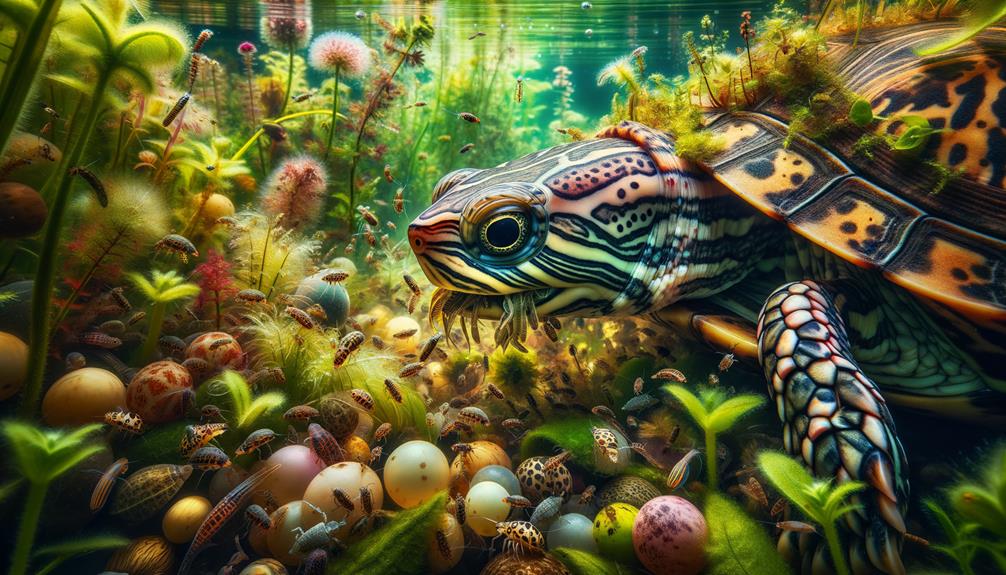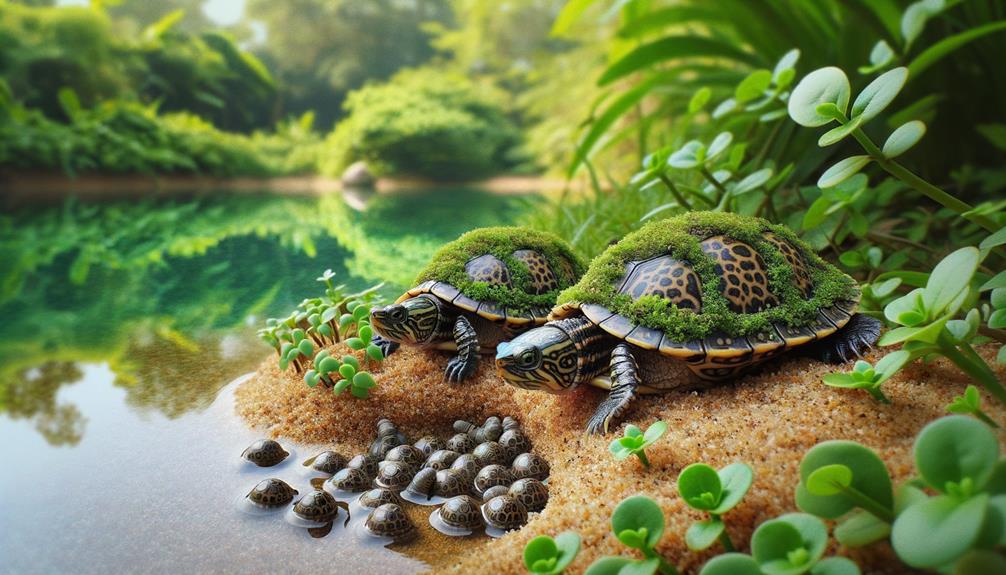I marvel at the intricate beauty of spotted turtles, with their bluish-black shells adorned with vivid yellow spots. These turtles thrive in shallow wetlands, blending into the dappled sunlight and leaf litter. Their strong, beak-like jaws make easy work of a diet rich in aquatic plants, insects, and small vertebrates. Watch as they navigate their habitat, showcasing peak activity from mid-February through May, often making perilous overland journeys. Females carefully select nesting sites, laying eggs in protected areas, but sadly, only a fraction of hatchlings survive to adulthood. With their striking patterns and critical habitat needs, there's much to learn about these fascinating creatures.
Key Takeaways
Spotted turtles have a striking appearance, with a bluish-black carapace adorned with bright yellow spots, creating a unique, dappled pattern.
The yellow spots on their shells help them blend into their surroundings, making it easier to hide in leaf litter and dappled sunlight in their wetland habitats.
These turtles thrive in shallow wetlands, marshes, and slow-moving streams across the eastern United States.
Their smooth, flattened carapace enhances camouflage and protection in their natural environment.
Spotted turtles' unique shell patterns are crucial for their survival, as they aid in concealment from predators.
Habitat and Distribution
Spotted turtles, with their distinctive dappled shells, thrive in the shallow wetlands, marshes, bogs, and slow-moving streams that dot the eastern United States. I've always been fascinated by their habitats, which stretch from the coastal regions of Georgia and Florida up to southern Maine and southern Canada. These turtles, adorned with yellow spots on their black scutes, seek the freedom of damp banks and blackwater pools.
In these serene environments, they blend effortlessly into the leaf litter, their spots mimicking the dappled sunlight filtering through the canopy. The shallow water provides just the right conditions for them to flourish, offering both safety and sustenance. The northeastern states, such as New York, New Jersey, and Pennsylvania, boast the highest densities, where wetlands teem with life.
However, habitat loss poses a significant threat. The destruction and degradation of these pristine wetlands disrupt the delicate balance that spotted turtles rely on. As urban development and agricultural expansion encroach on these coastal regions, spotted turtle populations have seen a significant decline.
It's a poignant reminder that these creatures, with their intricate yellow-spotted shells, need our protection to preserve the freedom of their natural habitats.
Diet and Feeding Habits

When observing spotted turtles in their natural habitats, I'm always fascinated by their varied diet, which includes aquatic plants, insects, crustaceans, and small vertebrates. Their sharp, beak-like jaws allow them to efficiently capture prey like worms, snails, and crayfish. Interestingly, they adapt their feeding habits to seasonal changes, shifting from invertebrates to more plant-based foods as they mature.
Preferred Food Sources
In their pursuit of sustenance, spotted turtles demonstrate remarkable adaptability, feeding on a diverse range of aquatic plants, small invertebrates, amphibians, and even carrion in their wetland habitats. This varied diet highlights their opportunistic feeding habits, enabling them to thrive in dynamic ecosystems.
Spotted turtles show a preference for certain foods:
- Aquatic plants: They favor duckweed and water lilies, which provide essential nutrients.
- Invertebrates: Caddisfly larvae and dragonfly nymphs are staples in their diet, along with other small invertebrates.
- Amphibians: Small fish and frogs supplement their diet with protein.
- Carrion: They don't hesitate to scavenge, consuming dead animals when the opportunity arises.
With their sharp, beak-like jaws, these turtles skillfully capture and consume prey, often feeding along the bottom of wetlands. Hatchlings and juveniles primarily target small invertebrates, honing their hunting skills on caddisfly larvae and dragonfly nymphs. As they mature, their palate expands to include a mix of aquatic plants and amphibians.
Their feeding habits reflect their adaptability and resilience. By exploiting a wide range of food sources, spotted turtles embody flexibility and opportunism in their aquatic environments, ever-ready to seize the next opportunity.
Seasonal Diet Changes
Throughout the year, spotted turtles adapt their diet to the changing seasons, reflecting the dynamic nature of their wetland habitats. In the vibrant spring and summer months, they take full advantage of the abundance around them. They mainly forage on emerging aquatic vegetation, small fish, frogs, and a diverse array of invertebrates, including insects and crustaceans. This flexibility in their feeding strategies allows them to thrive in fluctuating conditions.
As autumn approaches, their diet shifts significantly. They start consuming more plant-based foods, such as algae and submerged aquatic plants, which are abundant and easier to find in cooler temperatures. This plant-heavy diet is crucial as they prepare for brumation, the turtle equivalent of hibernation. This shift ensures they have sufficient energy reserves to survive the colder months.
Interestingly, juvenile spotted turtles tend to be more carnivorous, favoring small crustaceans and insects, whereas adults increasingly incorporate plant matter into their diets. Research indicates that habitat type influences their feeding habits; populations in stagnant wetlands consume more plant material compared to those in flowing streams. This adaptability in diet highlights the spotted turtle's resilience and resourcefulness in ever-changing environments.
Behavior and Movement

Spotted turtles primarily dwell in shallow wetlands and marshes, exhibiting fascinating homing behavior, often returning to their familiar small wetland areas, as documented in mark-recapture studies in Georgia. During their peak activity period from mid-February through May, these turtles are frequently observed, with over 90% of sightings occurring within this window. Their movements are a testament to their resilience and connection to their aquatic habitats.
Observing their behavior, I've noted:
- Homing Behavior: They consistently return to specific wetland areas, showcasing a strong sense of habitat connectivity.
- Overland Movements: These turtles make perilous journeys between wetlands, often crossing roads, which tragically leads to high road mortality rates.
- Juveniles and Subadults: Young spotted turtles, tracked through mark-recapture efforts, provide valuable insights into their developmental movements and habitat preferences.
- Aquatic Habitat Utilization: They thrive in shallow, slow-moving waters, where they engage in feeding, mating, and other essential activities.
Their determination to traverse challenging terrains for better habitat connectivity underscores their tenacity. It's crucial to be aware of their movements, especially the risks they face, to ensure their conservation and continued vitality in their natural environments.
Physical Appearance

With their bluish-black carapace adorned in vivid yellow spots, the physical appearance of these turtles is truly striking. Each spotted turtle boasts a unique array of bright yellow spots scattered across its smooth, flattened carapace. Adults typically display between 20-40 spots, creating a striking pattern that not only dazzles the eyes but also serves as excellent camouflage in their natural wetland habitats.
The yellow spots aren't confined to the carapace alone. Their head, legs, and tail are also dappled with orange or yellow spots and streaks, adding to their enchanting appearance. When they first emerge as hatchlings, these turtles start with just one spot per carapace scute. As they age, more spots develop, gradually transforming their appearance from simple to intricate.
The smooth texture of their shells and the distinctive spotted pattern play a vital role in their survival, blending seamlessly with the dappled light and shadows of their environment. At every stage of life, from hatchling to adult, the spotted turtle's physical traits are a testament to the elegance and adaptability of nature. These vivid yellow spots aren't just beautiful; they're a lifeline in the wild.
Reproduction and Life Cycle

As I delve into the reproductive habits of spotted turtles, I'm struck by their springtime mating rituals. Female turtles lay 1-3 clutches of 3-5 eggs annually, and the survival rates of these hatchlings are heavily influenced by environmental factors, particularly temperature, which determines their sex.
Mating Season Timing
In early spring, from March to May, spotted turtles enter their mating season, marking the start of a critical phase in their reproductive cycle. During this period, male spotted turtles become more active, swimming vigorously and engaging in elaborate courtship displays to attract females. This fascinating display of nature showcases the intricate timing and behavior that ensure the species' survival.
As the mating season unfolds, several key events take place:
- Courtship Displays: Males nudge and circle around females, showcasing their vibrant spots to attract a mate.
- Mating Attempts: Successful courtship leads to copulation, a process essential for fertilization and the continuation of the species.
- Female Nesting: From May to July, females carefully select nesting sites and lay eggs.
- Incubation Period: The eggs undergo a 40-80 day incubation, during which the temperature determines the sex of the hatchlings.
The reproductive success of spotted turtles relies on these meticulous behaviors and precise timings. Females typically lay 1-3 clutches of 3-5 eggs annually, maintaining genetic diversity and population stability. The incubation period is particularly intriguing, as the temperature determines the sex of the hatchlings. This complex process is crucial for the conservation of these remarkable, vulnerable creatures.
Egg Laying Process
During the egg-laying process, female spotted turtles carefully select suitable nesting sites to give their eggs the best chance of survival. They prefer sites with well-drained, sandy or loamy soil, often near water sources. Once a suitable site is found, they dig a nest using their hind legs and carefully deposit 3-5 eggs per clutch. Remarkably, they may lay 1-3 clutches annually, extending the breeding season.
The temperature within the nest plays a critical role in determining the sex of the hatchlings. Higher temperatures typically produce female hatchlings, while lower temperatures favor males. This temperature-dependent sex determination showcases the spotted turtles' ability to adapt to changing environmental conditions. After about 40-80 days, the eggs hatch, bringing new life into the world.
Spotted turtles reach sexual maturity between 7-14 years, a testament to their slow but steady growth. Their remarkable longevity, living up to 65-110 years, ensures they have multiple breeding seasons to contribute to their population. The female's dedication to finding ideal nesting sites enhances the survival rates of her offspring, underscoring the importance of their adaptability in the wild. Each nesting season is a step towards maintaining the species' continuity in an ever-changing environment.
Hatchling Survival Rates
Hatchling Survival Rates
Female spotted turtles put in a lot of effort to nest, but only about 10-20% of their hatchlings will survive to adulthood. The journey from egg to adult is fraught with challenges, starting with the clutch size itself. Females typically lay between 3-5 eggs per clutch, but not all eggs will hatch due to various environmental and biological factors.
These young turtles are immediately vulnerable to predators like raccoons and skunks, which often raid nests and eat eggs and hatchlings. As juveniles, their high mortality rates can be attributed to several factors:
- Predation: Raccoons and skunks prey on eggs and hatchlings, reducing their numbers.
- The sex of hatchlings is influenced by the nest's temperature, which can affect the population dynamics if skewed excessively.
- Environmental Hazards: Flooding, drought, and habitat destruction further threaten their survival.
- Human Impact: Pollution and urban development encroach on their natural habitats, increasing mortality rates.
As these juveniles mature, reaching reproductive age between 7-14 years, the pressures ease slightly. However, only a small fraction will make it to adulthood, contributing to the spotted turtle's delicate population balance.
Conservation Status

The spotted turtle's population is declining at an alarming rate, and their conservation status is becoming increasingly precarious. Habitat loss and fragmentation, mainly due to wetland degradation and development, are major contributors to this decline. As wetlands disappear, so does the turtle's habitat, leading to population declines of up to 50% over the past three generations. This has pushed the species toward a federal threatened listing.
The pet trade is exacerbating these declines, with around 1,000 individuals exported from the U.S. annually, despite protection under the Convention on International Trade in Endangered Species (CITES). The demand for their dappled shells fuels a trade that wild populations cannot sustain.
Collaborative conservation efforts are crucial. Agencies, researchers, and the public must work together to gather vital data on the turtle's ecology through mark-recapture studies. These studies help clarify the factors affecting their survival and inform management strategies. In Georgia, where the spotted turtle is poorly understood, such research is vital.
Only through concerted efforts can we hope to reverse the trends threatening this species. It's clear what we need to do: protect the wetlands, regulate the pet trade, and work together on conservation.
Frequently Asked Questions
What Kind of Turtle Has Spots on Its Shell?
When rain falls, a specific turtle species comes to mind: the spotted turtle, Clemmys guttata. Its dark shell features yellow or orange spots, and it inhabits wetlands and marshes.
How Rare Is a Spotted Turtle?
Spotted turtles are a rare sight due to the ongoing destruction of their habitats and over-collection. With populations dwindling by as much as 50% and their ranges becoming increasingly fragmented, encountering one in the wild is a unique and special experience for nature enthusiasts.
Can Spotted Turtles Go in Their Shell?
Spotted turtles can retreat into their shells for protection, but they can't fully enclose themselves because their plastron lacks a hinge. Instead, they rely on blending in with their surroundings and staying still to avoid predators effectively.
Are Spotted Turtles Hard to Take Care Of?
Spotted turtles can be challenging to care for. They require a specific environment with pristine water, precise temperatures, and specific lighting. Their diet is varied and time-consuming to manage. Additionally, they need a long-term commitment from their owners, and there are legal regulations to consider.



